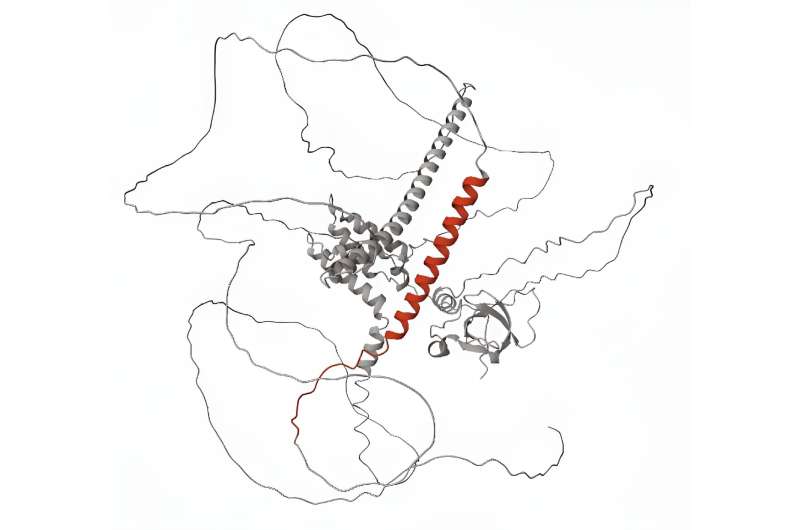This article has been reviewed according to Science X's editorial process and policies. Editors have highlighted the following attributes while ensuring the content's credibility:
fact-checked
trusted source
proofread
Abnormal proteins found in the spinal fluid of people with ALS and frontotemporal dementia

Researchers at the National Institutes of Health detected abnormal proteins in the spinal fluid of people with amyotrophic lateral sclerosis (ALS) and frontotemporal dementia (FTD), which could help improve diagnosis of these diseases. The findings were published in Science Translational Medicine.
The proteins in question are built from "cryptic" exons—abnormal portions of RNA, the cell's instructions for how to build proteins. Cryptic exons occur when TDP-43, a protein that regulates how RNA is processed, stops functioning normally. TDP-43 dysfunction is linked to ALS, FTD, Alzheimer's disease, and Limbic Associated TDP-43 Encephalopathy (LATE).
The study showed that these mis-spliced sections of RNA can sometimes generate new proteins from the cryptic sequence. The findings advance our understanding of how cryptic exons may be involved in the dementia disease process and could help identify diseases involving TDP-43 dysfunction before symptoms appear. Currently, TDP-43 aggregates in the brain can only be detected at autopsy.
Normally, TDP-43 helps control the production of proteins by regulating how RNA is processed. To function properly, TDP-43 must remain in the cell nucleus, where DNA is located. In ALS and other neurodegenerative diseases, TDP-43 leaks from the nucleus and instead forms abnormal clumps in the surrounding cytoplasm.
"We show that TDP-43 pathology causes brain cells to mis-splice hundreds of RNAs and that some of these RNAs are translated into new proteins that are not normally found in healthy cells," said Michael Ward, M.D., Ph.D., senior investigator at the National Institute of Neurological Disorders and Stroke (NINDS), co-director of the iPSC Neurodegenerative Disease Initiative at the NIH Intramural Center for Alzheimer's and Related Dementias (CARD) and senior co-author. "This conceptual discovery may enable future development of sensitive diagnostic tests to detect TDP-43 pathology in living patients."
Diagnosing ALS and related conditions can be challenging. There is currently no single test that can definitively diagnose ALS or FTD, and the symptoms can resemble those of other disorders. To help diagnose the disorders, doctors will perform a physical exam, assess the person's symptoms, conduct brain imaging, and use tests to rule out other conditions.
TDP-43 pathology is a defining feature in almost all patients with ALS and about half of those with FTD. It is also seen in roughly half of patients with Alzheimer's disease. However, current technology can't detect or measure TDP-43 pathology in living patients, hindering accurate diagnoses and therapy development.
The presence of cryptic exons typically destabilizes and degrades RNA transcripts, the RNA strands produced when a gene is transcribed. Until now, scientists had not explored the possibility that some cryptic exon transcripts are not degraded, but instead generate new proteins.
Using induced pluripotent stem cells (iPSCs) that model neurodegenerative disease, the research team developed a catalog of cryptic exons, and were able to identify 65 peptides that came from 12 cryptic exons. They then identified those same cryptic exons in post-mortem brain samples taken from people who had ALS/FTD spectrum disease and compared to healthy controls. The team followed up by confirming the presence of new resulting proteins in patient-derived iPSCs. They also showed that proteins containing cryptic sequences interacted with other proteins differently, likely altering their function.
The authors raised the possibility that these new proteins might be seen as foreign by our immune system, thereby trigger inflammation that could contribute to neurodegeneration. Finally, the team examined cerebrospinal fluid from patients with ALS/FTD spectrum disorders and identified 18 new proteins encoded by cryptic exons in 13 genes.
In addition to advancing our understanding of the biologic processes that give rise to neuronal death in ALS, FTD, and other TDP-43-associated neurodegenerative diseases, the study's finding of novel proteins in patients' spinal fluid may enable early diagnosis and serve as biomarkers that reflect a therapeutic response in clinical trials.
More information: Sahba Seddighi et al, Mis-spliced transcripts generate de novo proteins in TDP-43-related ALS/FTD, Science Translational Medicine (2024). DOI: 10.1126/scitranslmed.adg7162



















